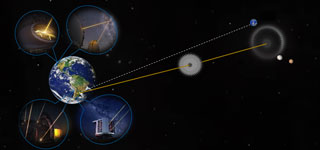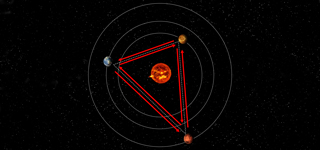Astrophysics


Programs

Hybrid Space-Ground Observatories: Revolutionizing the Search for Earth-like Exoplanets
This KISS study program will study hybrid ground-space observatories by integrating ground-based telescopes equipped with adaptive optics, and optical components placed in suborbital or orbital locations.

Interplanetary Laser Trilateration Network
The goal of this study program is to develop plans for a future planetary geodesy measurement protocol that would improve the state of the art for planetary ranging by up to three orders of magnitude, using a triad of spacecraft with laser communications deployed in orbit around Venus, Earth, and Mars.

Astronomical Optical Interferometry from the Lunar Surface
The lunar surface is a compelling opportunity for large, distributed optical facilities, with advantages over orbital facilities for high-spatial-resolution scientific applications. This KISS Study program will establish the feasibility of mission concepts that can be realistically developed in the near term, within existing funding lines.

Metasurface Optics for High-Contrast Imaging: Design, Fabrication, and Implementation
The workshop on "Metasurfaces for Exoplanet Detection and High-Contrast Imaging" aims to convene a diverse group of researchers, including end-users, designers, fabricators, and metrology experts, to explore and advance the application of metasurface optics in the field of astronomy and high-resolution imaging.

Blazing Paths to Observing Stellar and Exoplanet Particle Environments
This study will chart a course for the new field of planetary particle environment observation and observation-guided modeling.

Exploring Exoplanets with Interferometry
The focus of this study is on new concepts for interferometric observations for exoplanet research including how new micro-thruster technologies and innovative, new low cost spacecraft might enable separated spacecraft concepts such as the new Large Interferometer for Exoplanets (LIFE) mission now under study by ESA.

The Next-Generation Ground-Based Planetary Radar
The goal of this study is to explore approaches to the next-generation planetary radar capable of providing compelling science and complementing and motivating NASA science missions as well as potentially providing NASA mission assurance by being able to track spacecraft.

Beyond Interstellar: Extracting Science from Black Hole Images
A goal of the KISS study is to explore fundamental questions in black hole physics, to review the science motivation for event horizon scale probes, to assess and explore techniques to connect observations to the underlying black hole physics, and to evaluate what ancillary science might be possible with future space-enhancements to Earth-based arrays like the EHT.

Nebulae: Deep-Space Computing Clouds
The goals of this study program are to identify new science missions enabled by a nebula; to quantify benefit to traditional, existing, and planned science missions; to identify candidate mission architectures and demonstration milestones for follow on proposal development for all participants.

Data-Driven Approaches to Searches for the Technosignatures of Advanced Civilizations
The focus of the study is new approaches toward the search for intelligent life elsewhere in the Universe. We will explore the possible paths for a systematic exploration of observable parameter spaces derived from the modern sky surveys, using machine learning and other computational tools.

The Architecture of LISA Science Analysis: Imagining the Future
The space-based gravitational-wave observatory LISA will offer unparalleled science returns, including a view of massive black-hole mergers to high redshifts, precision tests of general relativity and black-hole structure, a census of thousands of compact binaries in the Galaxy, and the possibility of detecting stochastic signals from the early Universe. The broad objective of this study program is to imagine how evolved or rethought data-analysis algorithms and source-modeling codes will solve the LISA science analysis on the computers of the future.

Designing Future CMB Experiments
This study will address the design and concept of future Cosmic Microwave Background (CMB) experiments and in particular a future CMB satellite to extract cosmological information from the polarized CMB photons. The research will aim at deriving forecasts of the optimal (instrumental and observational) parameters of future CMB experiments, considering technical and hardware aspects along with theoretical modeling, astrophysics and statistics.

Exoplanet Imaging and Characterization: Coherent Differential Imaging and Signal Detection Statistics
This workshop seeks to address several questions related to the development of statistically grounded strategies for detecting faint signals in the presence of both coherent and incoherent backgrounds.

Optical Communication on SmallSats – Enabling the Next Era in Space Science
This study will bring together space scientists, technologists, and mission designers across two workshops to understand the current limitations faced by SmallSat science missions stemming from the communication bottleneck, and together craft novel technical approaches for optical data transfer that significantly enhances the quality and volume of data returned by these missions.

Optical Frequency Combs for Space Applications
The goal of this program is to formulate space applications and mission concepts enabled by optical frequency comb technology and to identify high priority technology challenges and gaps that need to be addressed to implement these missions.

Bridging the Gap: Observations and Theory of Star Formation Meet on Large and Small Scales
The purpose of this study program is to generate new ideas for new observations that can be used to constrain models and develop requirements for future instruments and space missions.

Science and Enabling Technologies to Explore the Interstellar Medium
The technical challenge and the focus of the study is to assess mission implementation techniques that will enable affordable robotic probes to reach the ISM within 10 years.

Airships: A New Horizon for Science
The goal of this study is to identify science observational/experimental projects that are uniquely addressed by airship vehicles, and determine which of these science goals could be simultaneously accommodated in one platform.

Planetary Magnetic Fields: Planetary Interiors and Habitability
This study will assess the current state of knowledge about planetary magnetic fields, track the progress of the new ground-based instruments and develop observing strategies from existing optical/UV telescopes.

Digging Deeper: Algorithms for Computationally-Limited Searches in Astronomy
Our technical goal is to develop a few realistic, benchmark problems on which the methods can be compared, keeping in mind computational resources and available architectures.

Next Generation UV Instrument Technologies Enabling Missions in Astrophysics, Cosmology and Planetary Sciences
The goal of this study is to create a new paradigm in UV/Optical instrument design, detector technology, and optics to form the foundation for the next generation of UV/Optical missions.

The First Billion Years
This study is structured around the principal theme of diffuse spectral radio/mm/sub-mm observations that target atomic and molecular lines as tracers of matter in the pre- and inter-galactic medium and early structures.

Single Photon Counting Detectors
This study was designed to significantly advance the capability to build single photon counting array detectors at submillimeter to ultraviolet wavelengths for astronomy, including optical single photon detectors for communications.

Innovative Approaches to Exoplanet Spectra
This program aims to take a fresh look at exoplanet characterization science from the point of view of new instruments that could do breakthrough science or that could pave the way for the next generation of space missions.

Coherent Arrays for Astronomy and Remote Sensing
The objective of this program is to explore the science that would be enabled by large MMIC arrays for cosmology, astrophysics, planetary science, atmospheric science, and remote sensing of the Earth.

Large Space Structures
The aim of this program is to analyze the state of the art in optical and RF apertures and to make a lasting impact on the field of large space apertures.

Shedding Light on the Nature of Dark Matter
The goals of this mini-program are to bring together diverse theoretical and observational perspectives on dark matter particle candidates and their properties, astrophysical expressions, and the observations today and in the future that may solve the problem of the nature of dark matter.

Innovative Concepts in IR/Submm Astronomy from Space
This study is a forum to explore new concepts that enable major scientific advances at modest cost in the far-IR / submm spectral range.
Lectures & Webinars
Interstellar Comets – Visitors from Another Solar System – Natural or Artificial?
September 14, 2021
Speaker: Dr. Karen Meech - University of Hawai’i

The Ultraviolet Spotlight on Exoplanets
January 25, 2021
Speaker: Professor Evgenya Shkolnik - Arizona State University

FARSIDE: A Probe-Class Mission to Place a Radio Telescope on the Lunar Farside
October 19, 2020
Speaker: Professor Gregg Hallinan - Caltech

Telescopes, Astronomical Discoveries, and Their Influence on Literature
September 26, 2019
Speaker: Anna Ho – Caltech

The SPHEREx All-Sky Infrared Spectral Survey Satellite
May 6, 2019
Speaker: Professor Jamie Bock - Caltech/JPL

Dusty Planetary Systems and the Hunt for Planets
August 13, 2018
Speaker: Professor Farisa Morales – JPL/Moorpark College/CSUN

Parker Solar Probe: Exploring the Plasma Physics of the Solar Corona and Inner Heliosphere
July 19, 2018
Speaker: Prof. Marco Velli - Earth, Planetary and Space Sciences, UCLA; Astrophysics and Space Sciences, JPL; Parker Solar Probe Observatory Scientist

Magnifying Light by 100 Billion Times with the Solar Gravity Lens to Image an Exoplanet
May 16, 2018
Speakers: Slava G. Turyshev (Physicist, JPL) and Louis Friedman (Co-Founder and Executive Director Emeritus, The Planetary Society)

The Interstellar Age
February 22, 2018
Speaker: Professor Jim Bell - Arizona State University

Heliophysics and the Great American Total Solar Eclipse of 2017
June 28, 2017
Speaker: Prof. Jay Pasachoff - Williams College, Williamstown, MA. Visitor, Division of Geological and Planetary Sciences (GPS), Caltech

An Interstellar Conversation
September 9, 2014
Moderator: Dr. Leon Alkalai - Ast. Div. Mgr, Systems Engineering & Formulation Division, JPL

Science in Cyberspace
December 13, 2011
Speaker: Professor S. George Djorgovski

Many Suns, Many Worlds: The Galactic Quest for Exoplanets
October 4, 2010
Speakers: Professor Eric Ford, University of Florida; Professor Jason Wright, Pennsylvania State University; Professor Natalie Batalha, San Jose State university; Dr. Mark Swain, NASA/Jet Propulsion Laboratory

Seismology of the Sun and Stars
March 17, 2010
Speaker: Professor Laurent Gizon - Max-Planck-Institut für Sonnensystemforschung

Single Photon Detectors - from A to B (from Astronomy to Biology, and Beyond)
January 26, 2010
Speaker: Professor Daniel Prober, Yale University

Co-Sponsored Events
Leaders in Space Exploration
Symposia
Dark Matter in Southern California (DaMaSC) SERIES:
DaMaSC - IV: Beyond WIMP Dark Matter
August 30, 2017DaMaSC - III: Dark Matter Signals from the Galactic Center and Beyond
April 17, 2014DaMaSC - II
September 24, 2013DaMaSC - I
January 25, 2013




